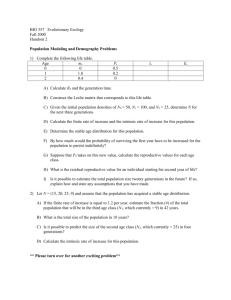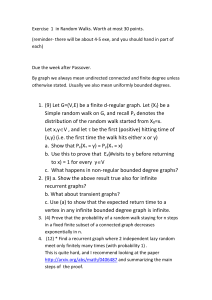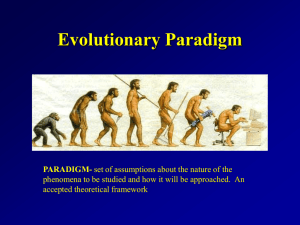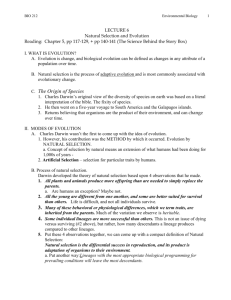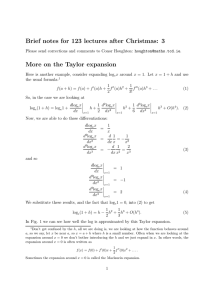Net Reproductive Rate versus Intrinsic Capacity for Increase
advertisement
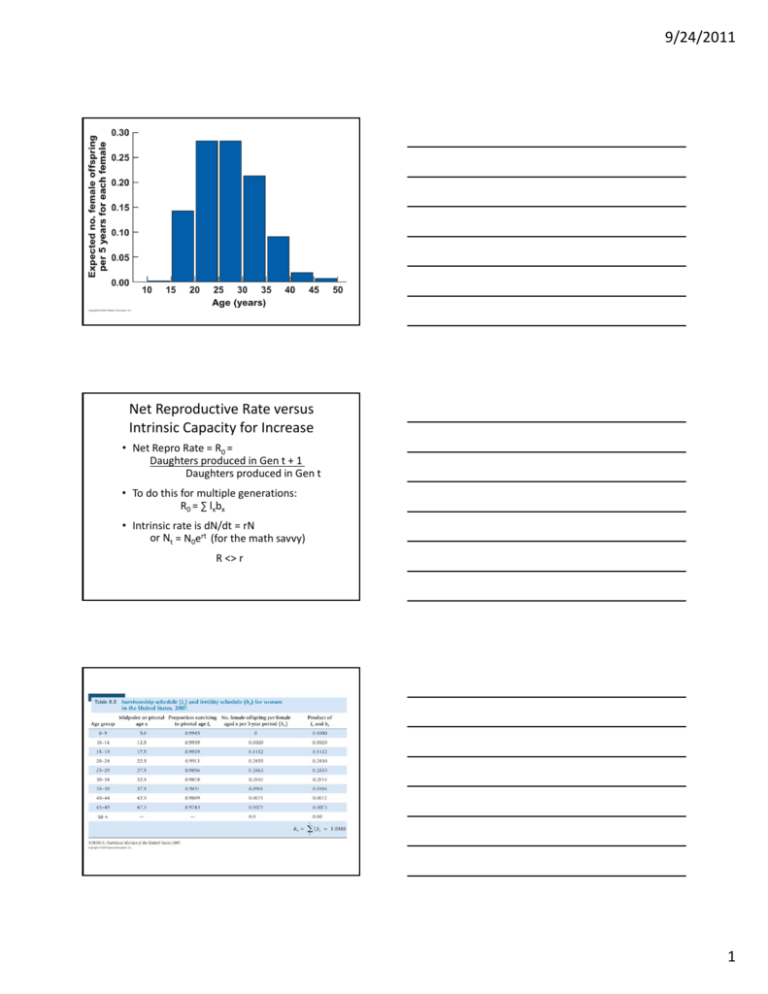
9/24/2011 Net Reproductive Rate versus Intrinsic Capacity for Increase • Net Repro Rate = R0 = Daughters produced in Gen t + 1 Daughters produced in Gen t • To do this for multiple generations: R0 = ∑ lxbx • Intrinsic rate is dN/dt = rN or Nt = N0ert (for the math savvy) R <> r 1 9/24/2011 Log vs. Arithmetic Scale 2 9/24/2011 Per Generation – what’s that? • The mean period elapsing between the production of parents and production of offspring • Gx = ∑ lxbxx/∑ lxbx = ∑ lxbxx/R0 3 9/24/2011 Deriving r (finally) • The instantaneous rate of increase is r – We haven’t figured out how to get r before this… • r = loge(R0)/G – for our example, r = loge(3.0)/1.33 • And the finite rate of increase λ (Lambda) is er – This will come in handy later Keeping Rr Terms Straight • Net rate R0 is per generation – It is calculated cumulatively over all age classes – If R0 is 1 then the population is not growing – It is a finite rate • Intrinsic rate r is the potential rate of growth under a certain set of conditions – – – – It is a single value and not calculated cumulatively It is an instantaneous (short time interval) rate If r is 0 (zero), then the population is not growing λ is a conversion of r back into a finite rate “Interestingly,” finite rate = einstantaneous rate and instantaneous rate = loge finite rate (geeks please see Appendix II) 4 9/24/2011 Why Intrinsic Matters Two scenarios, Same # of Offspring 5 9/24/2011 Reproductive Value • Reproductive Value (for a stable population) Vx = ∑ ltbt/lx t=x (Q for you: Why is Vx = R0 when t = 0?) Age Distribution • If Cx is the proportion of organisms in a particular age category, then: Cx = λ‐xlx/∑ λ‐ili (λ‐x is the same as 1/λx) • Returning to our make‐believe example in Figure 8.11: 6 9/24/2011 Back to Our Example (p 129) • Follow calculations on p 133 using above: – C0 = [(1.0)*(1.0)]/1.6572 = 0.6035 – C1 = [(0.4144)*(1.0)]/1.6572 = 0.25 – C3 = 0.104 and C4 = 0.043 • It worked! – And we have a stable age distribution Stationary Age Distribution • In the previous example, survivorship was high and the population grew rapidly • As mortality and natality balance each other out, the population becomes stable • If conditions remain stable, then the age distribution will also become stable, and you get a stationary age distribution • This can only occur if population size and the distributions of lx and bx are also unchanging – In reality, these things are always in flux 7 9/24/2011 Stable vs. Stationary Age Distributions 8 9/24/2011 Evolution of Demography An Interesting Outcome • It only takes a small amount of additional reproduction for annual to catch perennial 9 9/24/2011 Reproductive Considerations • If risk of dying is high for adults, it might pay to put energy into more offspring sooner • If chances of success in a particular year are poor, then it might be better to stay alive and keep trying • If reproduction is taxing (it is) then this may influence when to reproduce (i.e., delay) • But can’t wait for too long (won’t be here) 10 9/24/2011 11
